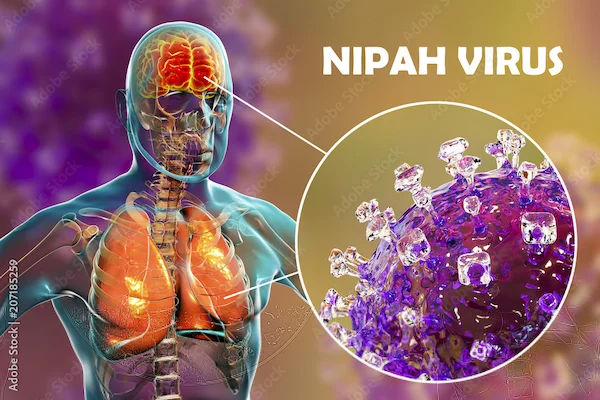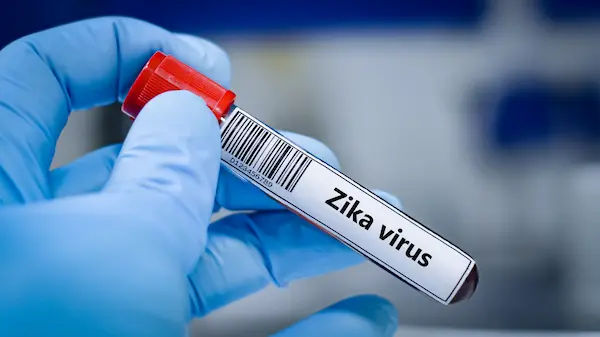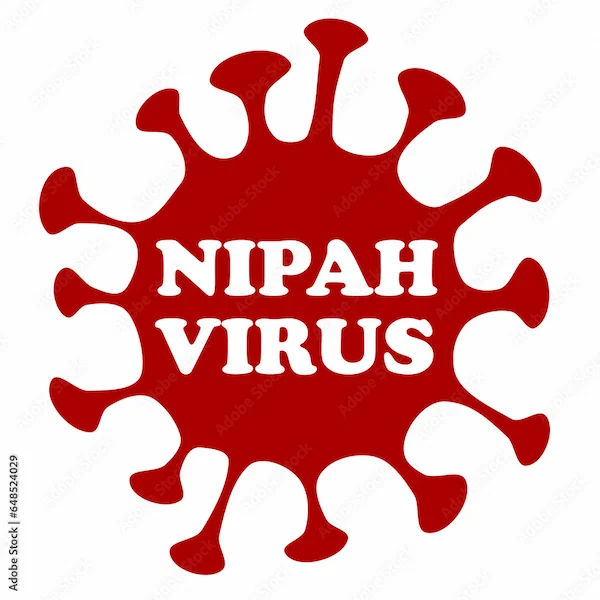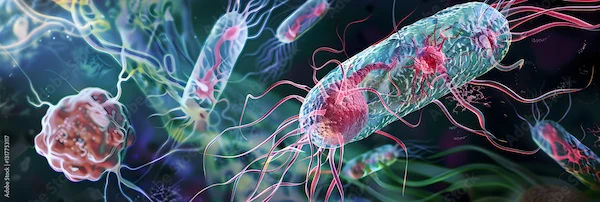Nipah Virus: A Comprehensive Guide to Symptoms, Spread, and Safety
Learn about Nipah virus symptoms, how it spreads, prevention strategies, and current treatment options. Stay informed and safe with this complete guide.

Written by Dr. D Bhanu Prakash
Reviewed by Dr. Mohammed Kamran MBBS, FIDM
Last updated on 6th Oct, 2025

Introduction
When a new virus emerges, it can understandably cause widespread concern. Among the most dangerous of these emerging pathogens is the Nipah virus. Classified as a zoonotic virus—meaning it jumps from animals to humans—Nipah has caused several outbreaks with alarming fatality rates, sometimes reaching up to 75%. But what exactly is this virus, and should you be worried? This guide aims to demystify everything you need to know about the Nipah virus, separating fact from fiction. We will explore its origins, how it spreads, the critical symptoms to recognise, and, most importantly, the practical steps you can take to protect yourself and your family. Understanding this threat is the first and most crucial step in prevention, moving from fear to informed awareness.
What is the Nipah Virus?
The Nipah virus (NiV) is a rare but severe pathogen that can cause encephalitis (brain inflammation) and respiratory illness in humans. It belongs to the genus Henipavirus, a family of viruses known for their potential to cause significant disease outbreaks.
Origin and History: From Malaysia to Global Concern
The virus was first identified in 1999 during an outbreak among pig farmers in Malaysia and Singapore. The name "Nipah" comes from the village in Malaysia where the first case was reported. The outbreak highlighted the virus's ability to spread from animals to humans and then between humans, leading to over 100 deaths. Since then, annual outbreaks have been recorded in Bangladesh and India, with occasional cases in other parts of Asia. This history underscores its persistent threat to public health.
How the Nipah Virus Affects the Body
After entering the body, the virus has an incubation period ranging from 4 to 14 days (though it can extend to 45 days). It initially replicates in the respiratory tract before entering the bloodstream (viraemia). The virus then crosses the blood-brain barrier, attacking the endothelial cells of the brain's blood vessels, leading to vasculitis (inflammation of blood vessels), thrombosis (blood clots), and ultimately, the severe neurological symptoms that characterise the disease.
How Does Nipah Virus Spread?
Understanding the transmission pathways of the Nipah virus is key to prevention. The virus spreads through several distinct routes.
Animal-to-Human Transmission: The Primary Source
The natural host for the Nipah virus is the fruit bat of the Pteropus genus, also known as flying foxes. These bats carry the virus without getting sick themselves. Humans can become infected through:
Direct Contact: Handling sick bats or their excretions (urine, saliva).
Indirect Contact: Consuming food or water contaminated by bats. This is a major route, particularly raw date palm sap, which bats can contaminate while tapping the trees.
Human-to-Human Transmission: A Serious Concern
Once the virus jumps to humans, it can spread efficiently between people. This occurs through close contact with the respiratory secretions (droplets from coughing/sneezing), saliva, or urine of an infected person. This makes Nipah virus infection a significant risk in hospital and household settings, where carers are particularly vulnerable.
Consult Top Specialists for Personalised Tips
Contaminated Food: The Role of Raw Date Palm Sap
A culturally significant route of transmission in Bangladesh and India is the consumption of raw date palm sap. Bats frequent the trees where the sap is collected, contaminating the liquid with their urine or droppings. Boiling the sap kills the virus, but consuming it raw is a high-risk activity.
Recognising the Symptoms of Nipah Virus Infection
The symptoms of a Nipah virus infection can range from mild to severe and often progress rapidly. Early recognition is critical for seeking medical help and preventing spread.
Initial Symptoms: The First Signs to Watch For
The illness often begins with flu-like symptoms that can be easily mistaken for more common ailments. These initial signs include:
- Fever
- Headache
- Muscle pain (myalgia)
- Vomiting
- Sore throat
- Dizziness
- Drowsiness
These initial symptoms in humans can appear within days of exposure. If you experience these symptoms and have a history of potential exposure (e.g., in an outbreak area, contact with sick animals or people), it is crucial to seek medical attention immediately and inform the doctor of your potential risk.
Severe Complications: When the Virus Attacks the Brain
Within 24–48 hours, the disease can progress to severe neurological symptoms, indicating acute encephalitis:
- Drowsiness progressing to disorientation and confusion.
- Altered consciousness.
- Seizures.
- Coma.
Respiratory problems can also occur, including a severe cough and difficulty breathing. The mortality rate of Nipah virus is estimated to be between 40% and 75%, making it one of the deadliest pathogens known to humans.
How is Nipah Virus Diagnosed?
Diagnosis in the early stages is challenging due to the non-specific symptoms. However, laboratory tests are essential for confirmation. Diagnosis typically involves real-time polymerase chain reaction (RT-PCR) tests from throat or nasal swabs, cerebrospinal fluid, urine, or blood. Later in the illness or after recovery, an ELISA (Enzyme-Linked Immunosorbent Assay) test can detect antibodies. If you suspect exposure, a doctor can guide you on the necessary tests. Apollo24|7 offers convenient home collection for tests, allowing for safe sample collection if recommended by a physician.
Is There a Cure? Treatment Options for Nipah Virus
Currently, there is no specific antiviral drug or vaccine approved for the treatment for Nipah virus infection in humans. Management focuses on supportive care and preventing complications.
Supportive Care: The Mainstay of Treatment
This involves treating the symptoms to keep the patient stable. It includes:
- Ensuring proper hydration and nutrition.
- Managing fever and pain.
- Providing mechanical ventilation for respiratory support.
- Treating seizures and other neurological complications.
Experimental Therapies and Ongoing Research
The monoclonal antibody therapy m102.4 has been used on a compassionate-use basis and has shown promise. It is still considered experimental. Research into vaccines and antivirals is actively ongoing, given the virus's high pandemic potential.
Preventing Nipah Virus Infection: Your Best Defence
Since treatment is limited, prevention is paramount. How to prevent Nipah virus revolves around avoiding exposure.
Food Safety Practices to Eliminate Risk
- Avoid Raw Date Palm Sap: Do not consume raw date palm sap or toddy.
- Wash Fruits Thoroughly: Wash all fruits before eating, especially those with signs of bat bites.
- Cook Meat Thoroughly: Ensure all meat products are cooked well-done.
Protecting Yourself Around Sick Individuals or Animals
- Practice Hygiene: Wash hands frequently with soap and water.
- Use Protective Equipment: If caring for an infected person, use gloves, masks, and other personal protective equipment (PPE).
- Avoid Contact with Bats: Do not handle bats or enter areas where they roost.
- Isolate Infected Individuals: Implement infection control measures in healthcare settings and at home to prevent human-to-human transmission.
If you have been in contact with a confirmed case and develop symptoms beyond two weeks, consult a doctor online with Apollo24|7 for further evaluation and guidance on next steps.
Conclusion
The Nipah virus represents a serious but manageable public health threat. While its high fatality rate is alarming, the pathways for its spread are well-understood, and effective prevention strategies exist. Public awareness and adherence to food safety and hygiene practices are the most powerful tools we have to prevent outbreaks. Ongoing research continues to bring hope for future vaccines and treatments. By staying informed from reliable sources and taking practical precautions, individuals and communities can significantly reduce their risk. If you live in or are travelling to an area where outbreaks have occurred, remain vigilant. If your condition does not improve after trying these methods, book a physical visit to a doctor with Apollo24|7 for a professional diagnosis and care plan.
Consult Top Specialists for Personalised Tips

Dr. Avinash Pasuparthy
General Practitioner
5 Years • MBBS
Visakhapatnam
Apollo Clinic Vizag, Visakhapatnam

Dr. Ritesh Motghare
General Practitioner
18 Years • MBBS PGCDM
Nagpur
HEALTH CENTRE VNIT NAGPUR, Nagpur

Dr. Pankaj Tripathi
General Practitioner
20 Years • MBBS, MD Pathology
Lucknow
Best Diabetologist Clinic, Lucknow

Dr Syed Mateen Pasha
General Physician
2 Years • MBBS
Bengaluru
PRESTIGE SHANTHINIKETAN - SOCIETY CLINIC, Bengaluru

Dr. Anand Ravi
General Physician
2 Years • MBBS
Bengaluru
PRESTIGE SHANTHINIKETAN - SOCIETY CLINIC, Bengaluru
More articles from Fever
Frequently Asked Questions
Is there a vaccine for Nipah virus?
No, there is currently no commercially available vaccine for the Nipah virus. Several candidates are in various stages of development and testing.
What is the mortality rate of Nipah virus?
The case fatality rate is estimated to be between 40% and 75%, depending on the outbreak and local healthcare capabilities.
Can Nipah virus be transmitted through the air?
The primary mode of human-to-human transmission is through direct contact with respiratory droplets from an infected person. There is no evidence of efficient airborne transmission over long distances.
How can I protect myself during a Nipah virus outbreak?
Follow public health advisories strictly. Avoid consuming raw date palm sap, wash fruits thoroughly, practice good hand hygiene, and avoid contact with anyone who is sick or has been exposed.
Are there any long-term effects for Nipah virus survivors?
Yes, survivors of Nipah virus encephalitis can experience long-term neurological conditions, such as persistent seizures and personality changes.




